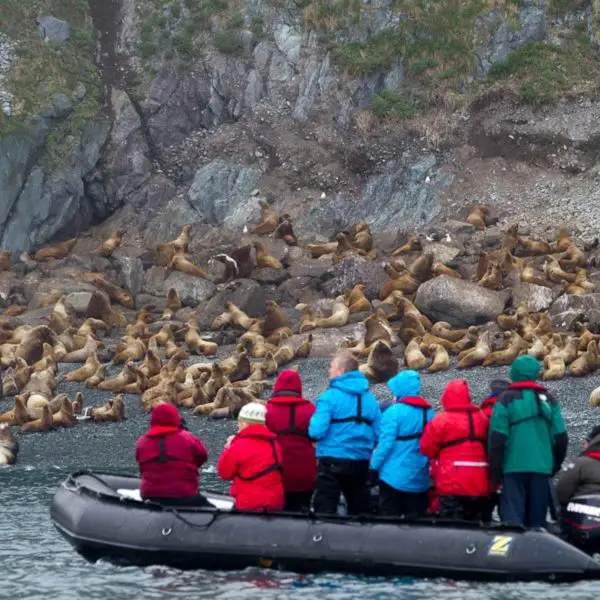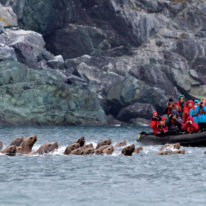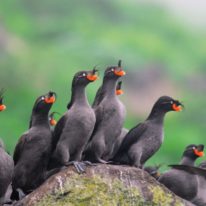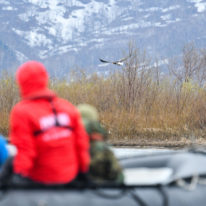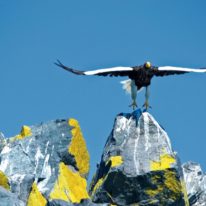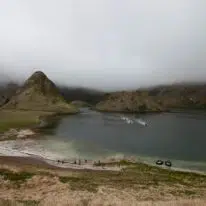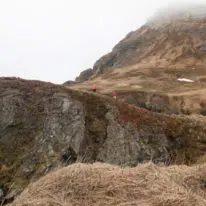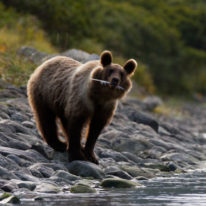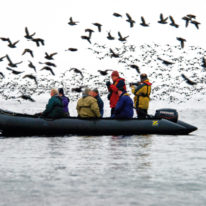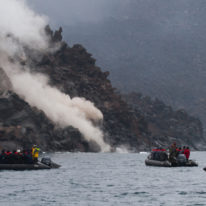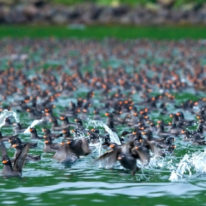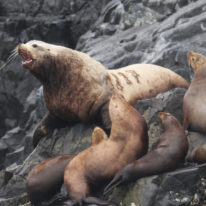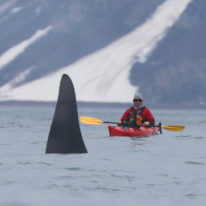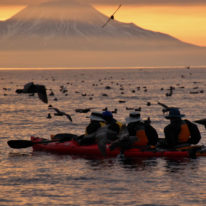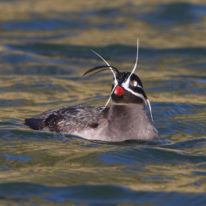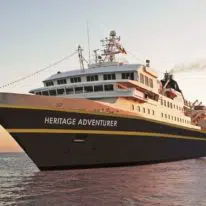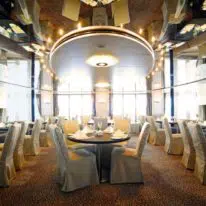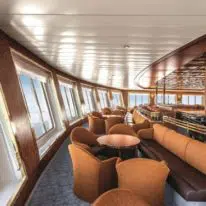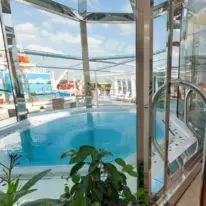Ring of Fire – Kamchatka, Commander & Kuril Islands Expedition Cruise
Duration14days
Price fromUSD $9,450 ?Currency ConversionConverted from USD based on the latest exchange rate. Final amount and payment will be in USD. Final conversion rate is determined by your bank.
Trip StyleExpedition Cruise
Time of yearMay - June
A once-in-a-lifetime Russia cruise in the spirit of the great explorers, embark on a Russia Far East Cruise of unparalleled adventure into the Pacific Ring of Fire. Here, Mother Nature still reigns supreme. Mighty volcanoes (mostly only half-asleep), cast their magnificent shadows across bizarre and beautiful landscapes.
Nowhere else on earth can the eruptive forces of nature be experienced more intensely than where the Pacific Ring of Fire meets the Russian Far East. Stretching for 50,000km around the Rim of the Pacific Ocean, most of the earth’s volcanoes are located around the edge of the Pacific Ring of Fire. Along with one of the world’s most active plate boundaries, millions of years of volcanic and geothermal activity have brought islands up from the sea and carved the land into the most unique and amazing shapes and formations.
Arrival
Otaru
Departure
Petropavlovsk-Kamchatsky
Accomodation
Heritage Adventurer
Trip style
Expedition Cruise
Duration
14 days / 13 nights
Action rating?
Group size
up to 140 passangers
Type of tour
Guaranteed departures
Itinerary
Day 1 Otaru (Japan)
Our expedition begins in Otaru, a port city in Hokkaido known for glassworks, music boxes, sake distilleries and picturesque Otaru Canal flanked with shops and cafes built within repurposed 1920s warehouses. Make your way to the designated meeting point for your transfer to Heritage Adventurer (times and meeting point will be confirmed with your voyage documents) where the captain and expedition team will be waiting to welcome you aboard. After clearing Japan Customs and Immigration, join the expedition team in the Observation Lounge or up on the Observation Deck as we set sail for Sakhalin Island. Once clear of the harbour there will be an introduction to the staff and ship, and a series of briefings. However we’ll aim to keep these as short as possible to allow you ample time to settle into your cabin and get out on deck to look for seabirds.
Day 2 Sakhalin Island (Russia)
We arrive at the Port of Korsakov on Sakhalin Island where we will clear Russian Customs and Immigration, time permitting we plan to have the opportunity to explore southern Sakhalin with the birders heading out to search for Sakhalin Leaf Warbler and Sakhalin Grasshopper Warbler as well as a number of other regional specialties which are also possible. Alternatively head into Yuzhno-Sakhalin to discover this historic town with its beautiful central park and modern cathedral. If the weather is favourable we should get great views of Tyatya Volcano, which at almost 1,819 metres dominates the landscape. This evening we sail for Kunashir Island.
Day 3 Kunashir Island
Kunashir is the largest island in the Kuril chain. The plan today will be to land ashore on Kunashir to visit the Kurilsky Reserve. Here we'll be able to explore an extensive area of woodland. A number of good walks in the island's forest interior are exceptionally productive for birding.
In the afternoon, it's time to depart the islands and head out to sea for the journey home, giving you an opportunity to recap and prepare for our arrival on land tomorrow.
Day 4 Iturup Island
If conditions are suitable we will enjoy an early morning Zodiac cruise looking for the Spectacled Guillemot and the Long-billed Murrelet. Today we plan to board the Zodiacs once again for the short ride to the community of Kurilsk where local buses will take us into the volcanic highlands of Iturup. Passing through some spectacular scenery as we steadily climb up towards the Baranskiy volcano, there may be an opportunity to soak in natural hot pools high in the mountains. The higher altitude and different vegetation gives us an opportunity to look for a range of new birds including Eastern Buzzard, Japanese Robin, Grey-bellied Bullfinch, Siberian Accentor, Pine Grosbeak and Kamchatka Leaf-warbler. On our return to Kurilsk there should be an opportunity to explore the village or explore the coastal habitats of Iturup with your naturalists including a Zodiac safari. Both Russet Sparrow and Chestnut-cheeked Starling are known to occur here and, depending on the tide, we may also find a good selection of gulls; there is often a good-sized roost here that can include Black-tailed, Slaty-backed, Glaucous-winged, Glaucous and Black-headed Gulls.
Day 5 Simushir and Yankicha Islands
After an early breakfast we plan to board the Zodiacs and cruise into a vast flooded caldera at the northern end of Simushir Island. Only a quarter of a century ago this was the location of a top secret Soviet submarine station where hundreds of mariners were based. This haunting reminder of the Cold War has now been completely abandoned and we can wander around what remains of the base, which is steadily being reclaimed by nature. Within the stunning setting of this huge caldera, we can expect to find a good range of species with one of the most common birds likely to be the spectacular Siberian Ruby-throat which can often be seen singing from the tops of scrubby bushes. Eurasian Nutcrackers also breed on the island and other species we have a good chance of encountering include Arctic Warbler, Brown-headed Thrush, Pine Grosbeak and Japanese Grey Bunting. Over lunch we plan to cruise to Yankicha Island, the summit of a submerged volcano. Invariably this is one of the highpoints of the entire voyage as the number of alcids breeding here is truly incredible. Subject to weather and sea conditions, we will use the Zodiacs to circumnavigate part of the coastline and then enter the flooded caldera. The concentrations of Crested and Whiskered Auklets here are simply spectacular and we can also expect to get great views of Brunnich’s and Common Guillemots and both Tufted and Horned Puffns. We should also see the snowy race of Pigeon Guillemot. While inside the caldera we will pass the breeding colonies of Crested and Whiskered Auklets and are likely to also find Harlequin Ducks. We also stand an excellent chance of seeing Arctic Foxes that can be pretty inquisitive as they patrol the auk colonies looking for their next meal. As we return to the ship in the late evening many of the alcids will be returning to their colonies. Being surrounded by clouds of birds darkening the sky is an experience you will never forget.
Day 6 Ekarma and Onekotan Islands
This morning we expect to be off Ekarma Island which, like so many of the islands in the Kuril chain, is an active volcano. The island is home to hundreds of thousands of breeding Northern Fulmars and we plan to Zodiac cruise along the coast enjoying the multitude of birds. Other species that breed here include both Tufted and Horned Puffns, we may even see some of the island’s resident Peregrines hunting alcids. This afternoon we plan to make a landing at the northern end of Onekotan Island from where it is a relatively easy walk to Black Lake. Our walk will take us through stunted areas of Siberian Stone Pine, Dwarf Birch and Polar Willow. At the time of our visit conditions should be spring-like and, as we make our way to and from the lake, there should be plenty of wild flowers in bloom including the possibility of some stunning orchids. On the lake a selection of wildfowl can usually be found including Greater Scaup and Goosander, while in the scrub we will be looking out for Buff-bellied Pipit, Brown-headed Thrush, Middendorff’s Grasshopper Warbler, Siberian Ruby-throat and Pine Grosbeak. On the beach where we land, and throughout the walk, there is extensive evidence of fortifications built by the Japanese during World War II. The Russians defeated the Japanese in the closing days of the war and although the islands have been considered Russian territory ever since, Japan still disputes Russian ownership of some of the Southern Kuril Islands.
Day 7 Atlasova Island, Second Kuril Strait Ptich’i Rocks
This morning we will arrive at Altasova Island where Alaid, the tallest volcano in the archipelago with an elevation of 2,340 metres, can be found. On the shore near our landing site are the remains of a Gulag and some small marshy ponds where it might be possible to see Longtoed Stint and other waders. On some nearby low cliffs there is a colony of Red-faced Cormorants and, out in the bay, there is a chance of finding Harlequin Ducks, Black and White-winged Scoters, Greater Scaup, Eurasian Wigeon and Falcated Ducks as well as Pacific Sea Otters. We then plan to sail through the Second Kuril Strait between Shumshu and Paramushir Islands on route to Ptich’i or Bird Rocks. The plan is to Zodiac cruise the wildlife rich Ptich’i Rocks where an abundance of birds, seals and Sea Otters reside at these fascinating formations. Sea Otters were hunted to almost extinction in Russia, but now number back to almost two-thirds of their historical range. Harbour and Largha Seals are often seen here as well as a healthy population of Tufted Puffins.
Day 8 Kamchatka, Russkaya Bay
Russkaya Bay is a deep fiord on the Kamchatka Peninsula where we’ll be on the lookout for the endangered Kittlitz’s Murrelet, as well as the Long-billed Murrelet.
A short excursion to the head of the fiord will give us a good chance of seeing Kamchatka Brown Bears. Cruising on the Zodiacs at the entrance to the fiord we almost always encounter Orcas and Stellar Sea Lions.
Day 9 Kamchatka, Zhupanova river
The scenic Zhupanova River is where we’ll spend several hours cruising in the Zodiacs, where we can expect to get great looks at the population of Steller’s Sea Eagles who nest in the trees along the riverbanks.
Other birding highlights may include Long-toed Stint, Kamchatka Gull, Aleutian Tern and Far Eastern Curlew. We can also pay a visit to the major salmon fishery located on the river.
Day 10 Olga Bay
Olga Bay is a part of the very large Kronotskiy Reserve, which also includes the world-famous Valley of the Geysers. The habitat is quite different to what we will have been experiencing before with lush Kamchatka forests coming right down to the beach line. There is a possibility we will see brown bears and other forest fauna, as well as multiple bird species that live in this habitat. The seas around Olga Bay are frequented by large numbers of Gray Whales that are usually quite friendly to the visiting boats, if the conditions are right we will take a Zodiac whale-watching cruise. The rising volcanoes in the background here provide a beautiful setting to explore real Kamchatka wilderness.
Day 11-12 Commander Islands
During our two days, we will explore the two main islands in the Commander group, Bering and Medny, making our way to several sites that combine the best of the island’s natural and cultural history.
On the birding front, we have an excellent chance to spot Mongolian Plover, Rock Sandpiper, Grey-crowned Rosy Finch and Pechora Pipit. We’ll also get the opportunity to observe the Commander’s endemic subspecies of Arctic Fox.
Zodiac Cruise around the island’s perimeters can be extremely rewarding, with several Auklet species and Red-legged Kittiwake. The waters surrounding the Commanders are incredibly rich in marine mammal activity. Potential cetacean species include Humpback, Sperm, Northern Minke Whale, Baird’s Beaked Whale and Orca, as well as Northern Fur Seals, Stellar Sea Lions and Pacific Sea Otters.
On Bering Island, we’ll pay a visit to the small fishing settlement of Nikolskoye and discover more about the island’s intriguing human history at the local museum.
Day 13 At sea
We have a day at sea as we cruise across the Kamchatka Trench towards Petropavlovsk- Kamchatskiy which is located at one of the greatest natural harbours in the world, Avacha Bay. These waters are renowned for cetaceans as the trench borders between two major tectonic plates creating deep canyons where these animals feed. Blue, Fin, Humpback, Sperm and Baird’s Beaked Whales have all been recorded here, as have Dall’s Porpoise and Orca, so there is real potential for some great cetacean sightings. There will, of course, also be birds to watch. Look out for Red-legged Kittiwake, Tufted Puffn, Ancient Murrelet and Fork-tailed Storm-Petrel.
Day 14 Petropavlovsk-Kamchatsky
This morning we arrive in the historic city of Petropavlovsk- Kamchatskiy, it will be worthwhile watching from one of the many vantage points as we sail into Avacha Bay. Petropavlovsk- Kamchatskiy is the main city of the Kamchatka Peninsula and the capital and administrative centre of the region. This city and the surrounding areas offer a great amount to see and explore. We encourage you to take a few extra days after the expedition to explore this amazing area, ask us about post-travel opportunities here. After a final breakfast, a coach will transfer you to a central city point or the airport.
Print this page
Save a printed version of this tour, so you can make a decision later
Send to my inbox
Email yourself or a friend the link for this tour
Ask a question
Have a question about this tour? Our experts will be happy to help
Inclusions
Airport arrival and departure transfers
Accommodation onboard Heritage Adventurer
3 daily meals onboard
All expeditions and shore excursions with professional leaders
Onboard lectures
Russian visa support document (invitation letter/voucher)
Exclusions
Flights
Russian visa and visa fees.*Russian visa can be arranged by 56th Parallel for an additional cost (for Australian citizens only). Apply for concierge visa service here.
Individual transfers
Ring of Fire – Kamchatka, Commander & Kuril Islands Expedition Cruise
14 days / 13 nights
*Price per person, based on twin share cabin
Make an enquiry Detailed ItinerarySimilar tours
Ring of Fire – Kamchatka, Commander & Kuril Islands Expedition Cruise
14 days / 13 nights
*Price per person, based on twin share cabin
Make an enquiryWhy travel to Russia with 56th Parallel?
Destination Specialists
Our team offers over 18 years of experience travelling and planning travel in Russia. Delivering outstanding travel experiences in Russia’s capitals and in some of the most stunning & remote locations takes experience, special access and the right connections. We make sure that all the fine details are handled perfectly so you can enjoy your Russia travel experience.
Group & Private Tours
The choice to join a small group on a guaranteed departure or chose to travel on your own dates with your own mates. Each destination we travel to in Russia offers an option between private tours and small group tours. Please note: on our adventure tours in remote destinations, we mostly run group tours to keep the cost down.
Bonded & Licensed
56th Parallel is a fully licensed, insured and accredited travel provider.



Ring of Fire – Kamchatka, Commander & Kuril Islands Expedition Cruise
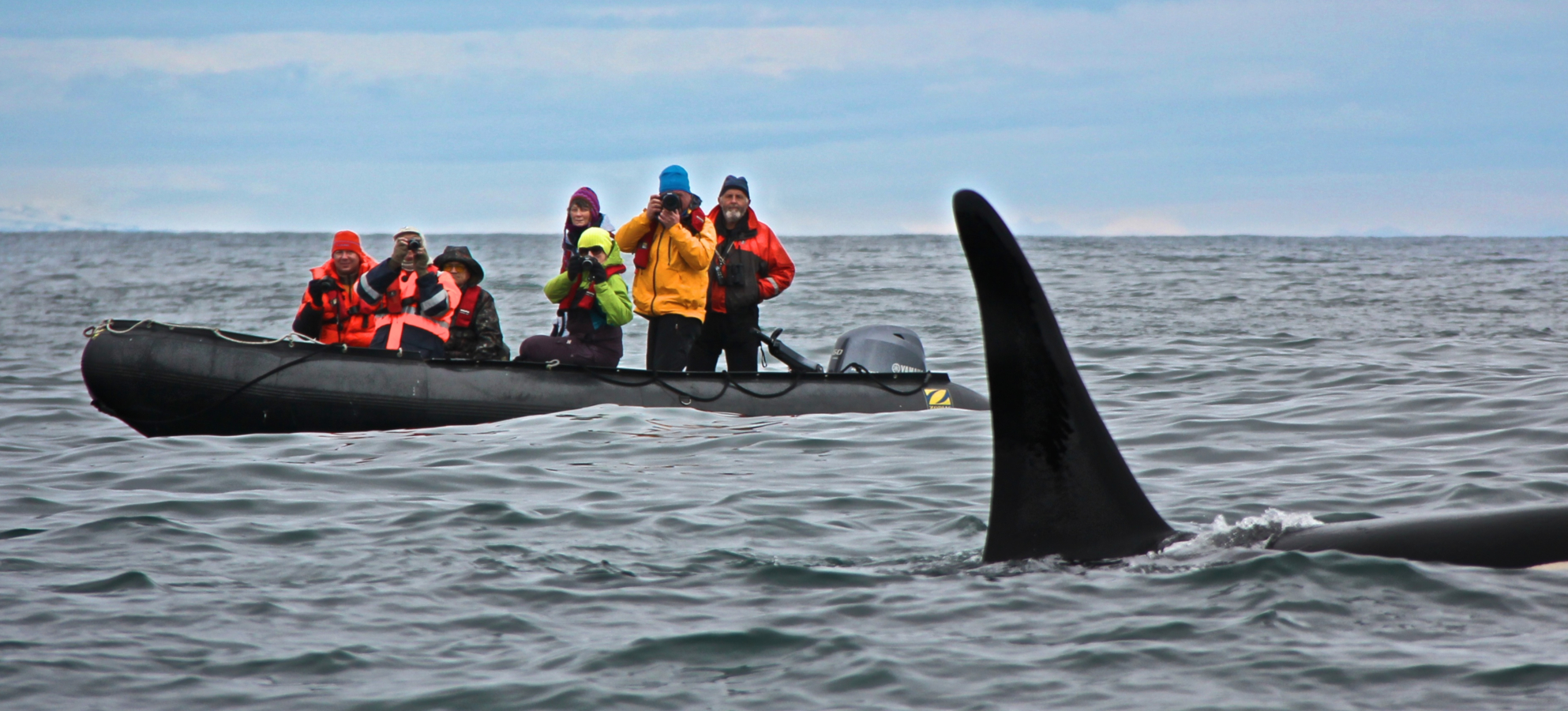
Days 14
From USD $9,450
Trip Style Expedition Cruise
Time of year May - June
Day 1: Otaru (Japan)
Our expedition begins in Otaru, a port city in Hokkaido known for glassworks, music boxes, sake distilleries and picturesque Otaru Canal flanked with shops and cafes built within repurposed 1920s warehouses. Make your way to the designated meeting point for your transfer to Heritage Adventurer (times and meeting point will be confirmed with your voyage documents) where the captain and expedition team will be waiting to welcome you aboard. After clearing Japan Customs and Immigration, join the expedition team in the Observation Lounge or up on the Observation Deck as we set sail for Sakhalin Island. Once clear of the harbour there will be an introduction to the staff and ship, and a series of briefings. However we’ll aim to keep these as short as possible to allow you ample time to settle into your cabin and get out on deck to look for seabirds.
Day 2: Sakhalin Island (Russia)
We arrive at the Port of Korsakov on Sakhalin Island where we will clear Russian Customs and Immigration, time permitting we plan to have the opportunity to explore southern Sakhalin with the birders heading out to search for Sakhalin Leaf Warbler and Sakhalin Grasshopper Warbler as well as a number of other regional specialties which are also possible. Alternatively head into Yuzhno-Sakhalin to discover this historic town with its beautiful central park and modern cathedral. If the weather is favourable we should get great views of Tyatya Volcano, which at almost 1,819 metres dominates the landscape. This evening we sail for Kunashir Island.
Day 3: Kunashir Island
Kunashir is the largest island in the Kuril chain. The plan today will be to land ashore on Kunashir to visit the Kurilsky Reserve. Here we'll be able to explore an extensive area of woodland. A number of good walks in the island's forest interior are exceptionally productive for birding.
In the afternoon, it's time to depart the islands and head out to sea for the journey home, giving you an opportunity to recap and prepare for our arrival on land tomorrow.
Day 4: Iturup Island
If conditions are suitable we will enjoy an early morning Zodiac cruise looking for the Spectacled Guillemot and the Long-billed Murrelet. Today we plan to board the Zodiacs once again for the short ride to the community of Kurilsk where local buses will take us into the volcanic highlands of Iturup. Passing through some spectacular scenery as we steadily climb up towards the Baranskiy volcano, there may be an opportunity to soak in natural hot pools high in the mountains. The higher altitude and different vegetation gives us an opportunity to look for a range of new birds including Eastern Buzzard, Japanese Robin, Grey-bellied Bullfinch, Siberian Accentor, Pine Grosbeak and Kamchatka Leaf-warbler. On our return to Kurilsk there should be an opportunity to explore the village or explore the coastal habitats of Iturup with your naturalists including a Zodiac safari. Both Russet Sparrow and Chestnut-cheeked Starling are known to occur here and, depending on the tide, we may also find a good selection of gulls; there is often a good-sized roost here that can include Black-tailed, Slaty-backed, Glaucous-winged, Glaucous and Black-headed Gulls.
Day 5: Simushir and Yankicha Islands
After an early breakfast we plan to board the Zodiacs and cruise into a vast flooded caldera at the northern end of Simushir Island. Only a quarter of a century ago this was the location of a top secret Soviet submarine station where hundreds of mariners were based. This haunting reminder of the Cold War has now been completely abandoned and we can wander around what remains of the base, which is steadily being reclaimed by nature. Within the stunning setting of this huge caldera, we can expect to find a good range of species with one of the most common birds likely to be the spectacular Siberian Ruby-throat which can often be seen singing from the tops of scrubby bushes. Eurasian Nutcrackers also breed on the island and other species we have a good chance of encountering include Arctic Warbler, Brown-headed Thrush, Pine Grosbeak and Japanese Grey Bunting. Over lunch we plan to cruise to Yankicha Island, the summit of a submerged volcano. Invariably this is one of the highpoints of the entire voyage as the number of alcids breeding here is truly incredible. Subject to weather and sea conditions, we will use the Zodiacs to circumnavigate part of the coastline and then enter the flooded caldera. The concentrations of Crested and Whiskered Auklets here are simply spectacular and we can also expect to get great views of Brunnich’s and Common Guillemots and both Tufted and Horned Puffns. We should also see the snowy race of Pigeon Guillemot. While inside the caldera we will pass the breeding colonies of Crested and Whiskered Auklets and are likely to also find Harlequin Ducks. We also stand an excellent chance of seeing Arctic Foxes that can be pretty inquisitive as they patrol the auk colonies looking for their next meal. As we return to the ship in the late evening many of the alcids will be returning to their colonies. Being surrounded by clouds of birds darkening the sky is an experience you will never forget.
Day 6: Ekarma and Onekotan Islands
This morning we expect to be off Ekarma Island which, like so many of the islands in the Kuril chain, is an active volcano. The island is home to hundreds of thousands of breeding Northern Fulmars and we plan to Zodiac cruise along the coast enjoying the multitude of birds. Other species that breed here include both Tufted and Horned Puffns, we may even see some of the island’s resident Peregrines hunting alcids. This afternoon we plan to make a landing at the northern end of Onekotan Island from where it is a relatively easy walk to Black Lake. Our walk will take us through stunted areas of Siberian Stone Pine, Dwarf Birch and Polar Willow. At the time of our visit conditions should be spring-like and, as we make our way to and from the lake, there should be plenty of wild flowers in bloom including the possibility of some stunning orchids. On the lake a selection of wildfowl can usually be found including Greater Scaup and Goosander, while in the scrub we will be looking out for Buff-bellied Pipit, Brown-headed Thrush, Middendorff’s Grasshopper Warbler, Siberian Ruby-throat and Pine Grosbeak. On the beach where we land, and throughout the walk, there is extensive evidence of fortifications built by the Japanese during World War II. The Russians defeated the Japanese in the closing days of the war and although the islands have been considered Russian territory ever since, Japan still disputes Russian ownership of some of the Southern Kuril Islands.
Day 7: Atlasova Island, Second Kuril Strait Ptich’i Rocks
This morning we will arrive at Altasova Island where Alaid, the tallest volcano in the archipelago with an elevation of 2,340 metres, can be found. On the shore near our landing site are the remains of a Gulag and some small marshy ponds where it might be possible to see Longtoed Stint and other waders. On some nearby low cliffs there is a colony of Red-faced Cormorants and, out in the bay, there is a chance of finding Harlequin Ducks, Black and White-winged Scoters, Greater Scaup, Eurasian Wigeon and Falcated Ducks as well as Pacific Sea Otters. We then plan to sail through the Second Kuril Strait between Shumshu and Paramushir Islands on route to Ptich’i or Bird Rocks. The plan is to Zodiac cruise the wildlife rich Ptich’i Rocks where an abundance of birds, seals and Sea Otters reside at these fascinating formations. Sea Otters were hunted to almost extinction in Russia, but now number back to almost two-thirds of their historical range. Harbour and Largha Seals are often seen here as well as a healthy population of Tufted Puffins.
Day 8: Kamchatka, Russkaya Bay
Russkaya Bay is a deep fiord on the Kamchatka Peninsula where we’ll be on the lookout for the endangered Kittlitz’s Murrelet, as well as the Long-billed Murrelet.
A short excursion to the head of the fiord will give us a good chance of seeing Kamchatka Brown Bears. Cruising on the Zodiacs at the entrance to the fiord we almost always encounter Orcas and Stellar Sea Lions.
Day 9: Kamchatka, Zhupanova river
The scenic Zhupanova River is where we’ll spend several hours cruising in the Zodiacs, where we can expect to get great looks at the population of Steller’s Sea Eagles who nest in the trees along the riverbanks.
Other birding highlights may include Long-toed Stint, Kamchatka Gull, Aleutian Tern and Far Eastern Curlew. We can also pay a visit to the major salmon fishery located on the river.
Day 10: Olga Bay
Olga Bay is a part of the very large Kronotskiy Reserve, which also includes the world-famous Valley of the Geysers. The habitat is quite different to what we will have been experiencing before with lush Kamchatka forests coming right down to the beach line. There is a possibility we will see brown bears and other forest fauna, as well as multiple bird species that live in this habitat. The seas around Olga Bay are frequented by large numbers of Gray Whales that are usually quite friendly to the visiting boats, if the conditions are right we will take a Zodiac whale-watching cruise. The rising volcanoes in the background here provide a beautiful setting to explore real Kamchatka wilderness.
Day 11-12: Commander Islands
During our two days, we will explore the two main islands in the Commander group, Bering and Medny, making our way to several sites that combine the best of the island’s natural and cultural history.
On the birding front, we have an excellent chance to spot Mongolian Plover, Rock Sandpiper, Grey-crowned Rosy Finch and Pechora Pipit. We’ll also get the opportunity to observe the Commander’s endemic subspecies of Arctic Fox.
Zodiac Cruise around the island’s perimeters can be extremely rewarding, with several Auklet species and Red-legged Kittiwake. The waters surrounding the Commanders are incredibly rich in marine mammal activity. Potential cetacean species include Humpback, Sperm, Northern Minke Whale, Baird’s Beaked Whale and Orca, as well as Northern Fur Seals, Stellar Sea Lions and Pacific Sea Otters.
On Bering Island, we’ll pay a visit to the small fishing settlement of Nikolskoye and discover more about the island’s intriguing human history at the local museum.
Day 13: At sea
We have a day at sea as we cruise across the Kamchatka Trench towards Petropavlovsk- Kamchatskiy which is located at one of the greatest natural harbours in the world, Avacha Bay. These waters are renowned for cetaceans as the trench borders between two major tectonic plates creating deep canyons where these animals feed. Blue, Fin, Humpback, Sperm and Baird’s Beaked Whales have all been recorded here, as have Dall’s Porpoise and Orca, so there is real potential for some great cetacean sightings. There will, of course, also be birds to watch. Look out for Red-legged Kittiwake, Tufted Puffn, Ancient Murrelet and Fork-tailed Storm-Petrel.
Day 14: Petropavlovsk-Kamchatsky
This morning we arrive in the historic city of Petropavlovsk- Kamchatskiy, it will be worthwhile watching from one of the many vantage points as we sail into Avacha Bay. Petropavlovsk- Kamchatskiy is the main city of the Kamchatka Peninsula and the capital and administrative centre of the region. This city and the surrounding areas offer a great amount to see and explore. We encourage you to take a few extra days after the expedition to explore this amazing area, ask us about post-travel opportunities here. After a final breakfast, a coach will transfer you to a central city point or the airport.
Included
Airport arrival and departure transfers
Accommodation onboard Heritage Adventurer
3 daily meals onboard
All expeditions and shore excursions with professional leaders
Onboard lectures
Russian visa support document (invitation letter/voucher)
Not included
Flights
Russian visa and visa fees.*Russian visa can be arranged by 56th Parallel for an additional cost (for Australian citizens only). Apply for concierge visa service here.
Individual transfers
If you have any urgent questions or enquiries, please give us a call +61 412 587 785
